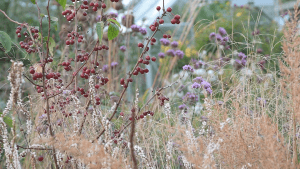Discovering a hazel dormouse

I was working at a clients garden earlier this week when I had a bit of a surprising wildlife experience. The weather has been cool and our first real frosts are forecast for this weekend. Autumn is coming.
I’d been cutting back herbaceous plants and raking out leaves from a border when I heard a high pitched squeaking. I followed the noise down to the ground near my feet and spotted a soft furry being curled up on the gravel.
It was a hazel dormouse, curled up in its hibernation posture. I must have raked them out of the border without noticing.
Dormice hibernate on the ground in nests made of local, dead vegetation.

This dormouse must have begun hibernating over the last few weeks and was now in such a deep state of slumber that they were barely aware that I had disturbed them.
Although it was a pleasure to see a dormouse in person (my first), I was sad to have broken their very important hibernation. After a few seconds of admiration, I quickly found a spot that I thought might be suitable and tucked them in. I don’t know if the disturbance that I caused will prove fatal for this little creature, but I really hope not.
The importance of leaving vegetation over winter
Many of us want our gardens to look pristine over winter. Leaves should be removed, shrubs pruned, herbaceous plants cut down to the ground. And although this can be aesthetically pleasing to us, it’s a disaster for our native wildlife.
The dead vegetation provides nesting material for animals. It also doubles up as a food source for the organisms living beneath the soil surface.
Unpruned branches give birds vertical pathways into our gardens. And congested stems provide vital cover for small animals trying to escape their hunters. Many seed heads remain intact throughout the colder months delivering energy packed seeds for any animals that want them.
Changing our mindset
Although “dead” plants are often seen as messy by us humans, they’re of vital importance to wildlife. If we can change our mindset, we will start seeing brown, straggly stems and thick layers of rotting leaves for what they are. Essential.
If you want to attract more wildlife to your garden, consider leaving as much of your “tidying” as you can to early spring. And even then, question whether you need to “tidy” it.
Leaves can be left on the surface. If they begin to smother plants in formal areas, a little intervention can be made. But consider moving them to another area or composting them (bumble bees nest in our compost pile and many more life forms live in it).
If you need to cut down perennials or prune woody plants, why not make a brash piles. They’re great for so many reasons.
If you can tolerate a little more mess than you used to, our amazing native wildlife species will be eternally grateful!



What a delightful little story, and the photos are gorgeous. Thanks for sharing this information which I find to be a good learning experience. I will always think of your ‘find’ amongst the leaves when I am ‘tidying’ areas in my garden and remember that ‘nature’ will appreciate me holding back a bit on neatening up possible animal and insect habitats. Please keep sharing these thoughts, ideas and good practice notes.